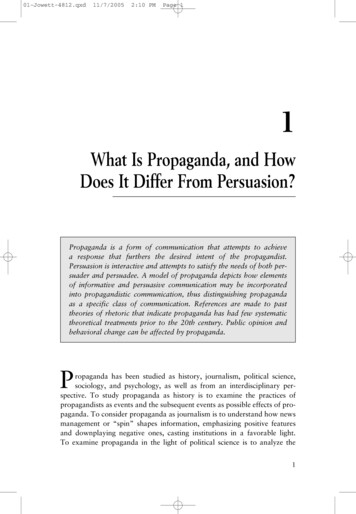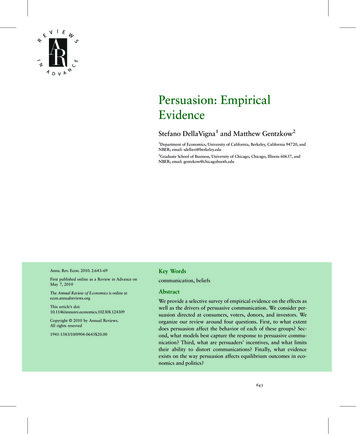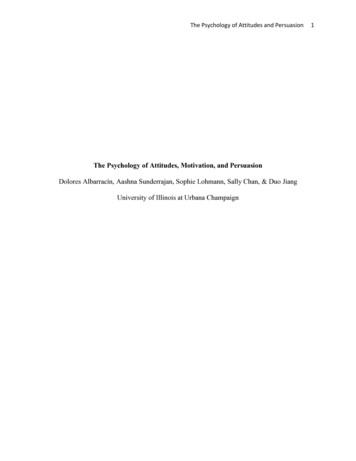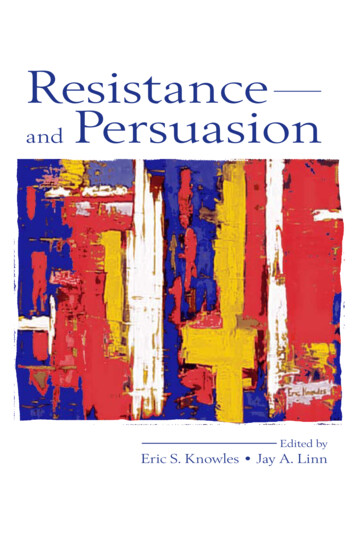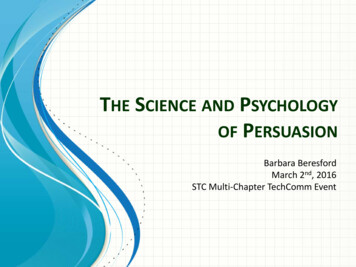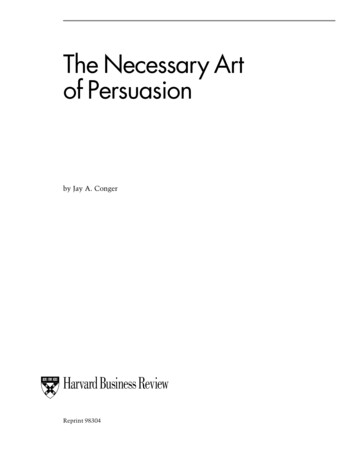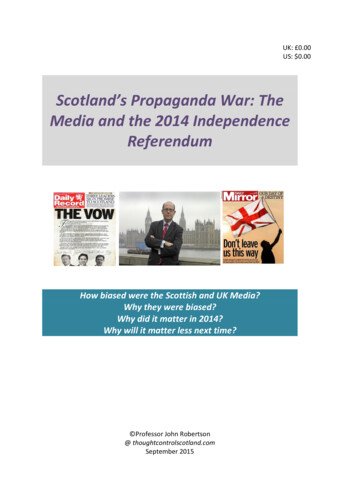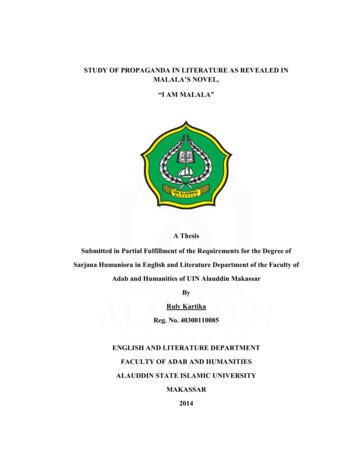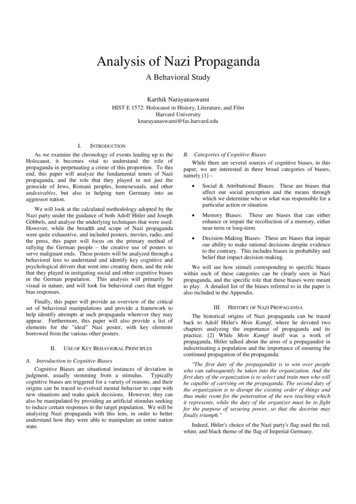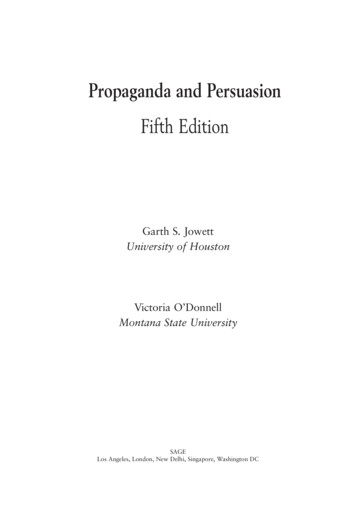
Transcription
Propaganda and PersuasionFifth EditionGarth S. JowettUniversity of HoustonVictoria O’DonnellMontana State UniversitySAGELos Angeles, London, New Delhi, Singapore, Washington DC
To Ada and May, who lived through two world wars and who, inanother time and place, took me to the movies.Garth S. JowettI continue to dedicate this book to the memory of my mother,Helen A. O’Donnell, a very special woman.Victoria O’Donnell
FOR INFORMATION:SAGE Publications, Inc.2455 Teller RoadThousand Oaks, California 91320E-mail: order@sagepub.comSAGE Publications Ltd.Copyright 2012 by SAGE Publications, Inc.All rights reserved. No part of this book maybe reproduced or utilized in any form or byany means, electronic or mechanical, includingphotocopying, recording, or by any informationstorage and retrieval system, without permissionin writing from the publisher.1 Oliver’s Yard55 City RoadLondon EC1Y 1SPPrinted in the United States of AmericaUnited KingdomLibrary of Congress Cataloging-in-Publication DataSAGE Publications India Pvt. Ltd.Propaganda and persuasion/edited by Garth S. Jowett,Victoria O'Donnell.—5th ed.B 1/I 1 Mohan Cooperative Industrial AreaMathura Road, New Delhi 110 044IndiaSAGE Publications Asia-Pacific Pte. Ltd.33 Pekin Street #02-01Far East Squarep. cm.Rev. ed. of: Propaganda and persuasion / Garth S. Jowettand Victoria O'Donnell. 4th ed. 2006.Includes bibliographical references and index.ISBN 978-1-4129-7782-1 (pbk.)Singapore 0487631. Propaganda. 2. Persuasion (Psychology)I. O’Donnell, Victoria. II. Jowett, Garth. Propagandaand persuasion.Executive Editor : Diane McDanielHM1231.J68 2012 303.3′75—dc22 2010045885Associate Editor :This book is printed on acid-free paper.Editorial Assistant :Production Editor : Astrid VirdingCopy Editor : Terri Lee PaulsenPermissions Editor :Typesetter : C&M Digitals (P) Ltd.Proofreader : Helen SalmonIndexer : Helen SalmonCover Designer : Helen SalmonMarketing Manager :12 13 14 15 16 10 9 8 7 6 5 4 3 2 1
Brief ContentsPreface to the First EditionxiiiPreface to the Second EditionxviiPreface to the Third EditionxxiPreface to the Fourth EditionxxiiiPreface to the Fifth EditionAcknowledgments1. What Is Propaganda, and How Does ItDiffer From Persuasion?xxvxxix12. Propaganda Through the Ages513. Propaganda Institutionalized974. Propaganda and Persuasion Examined1655. Propaganda and Psychological Warfare2116. How to Analyze Propaganda2897. Propaganda in Action: Four Case Studies3078. How Propaganda Works in Modern Society359References369Author Index000Subject Index000About the Authors395
Detailed ContentsPreface to the First EditionxiiiPreface to the Second EditionxviiPreface to the Third EditionxxiPreface to the Fourth EditionxxiiiPreface to the Fifth EditionAcknowledgments1. What Is Propaganda, and How Does ItDiffer From Persuasion?Propaganda Defined 2Jowett and O’Donnell’s Definition of Propaganda 6Forms of Propaganda 17Subpropaganda/Facilitative Communication 27A Model of Propaganda 29Communication Defined 30Propaganda and Information 31Propaganda and Persuasion 32Persuasion Defined 32Persuasion Is Transactional 33Responses to Persuasion 33Beliefs 35Values 35Attitudes 36Behavior 37Group Norms 37Resonance 38Persuasion Seeks Voluntary Change 38Misleading and Manipulating an Audience 39xxvxxix1
Rhetorical Background and the Ethics of Persuasion 39Rhetoric and Propaganda 43Propaganda as a Form of Communication 44Concealed Purpose 45Concealed Identity 45Control of Information Flow 45The Management of Public Opinion 47The Manipulation of Behavior 48Overview of the Book 492. Propaganda Through the AgesAncient Greece and Alexander the Great 53Alexander the Great 54Imperial Rome 56Propaganda and Religion 58The Rise of Christianity 63The Crusades 65The Reformation and Counter-Reformation 69The Counter-Reformation 74The Emergence of Propaganda 76The American Revolution 79The French Revolution and Napoleon 88Propaganda in the 19th Century:The American Civil War 94513. Propaganda InstitutionalizedThe New Audience 98The Emergence of Mass Society 101The Emergence of the Propaganda Critique 102The New Media 106Print Media 106Movies 110Radio 128U.S. Government Propaganda Agencies 137Radio and TV Marti 142Television 143Advertising: The Ubiquitous Propaganda 151Institutional Propaganda 152Internet Advertising 153The Science of Advertising 153The Role of Advertising 156Propaganda and the Internet: The Power of Rumor 15897
4. Propaganda and Persuasion ExaminedThe Modern Study of Propaganda and Persuasion 165Propaganda in World War I 166The Aftermath of World War I and the GrowingConcern About Propaganda 167The Social Sciences and the Study of Propaganda 169Research in Propaganda and Persuasion 170The Study of Attitudes 170World War II and Research inCommunication 171The Yale Studies 176Consistency Theories 177Theory of Exposure Learning 179Social Judgment Theory 179Resistance to Persuasion 180McGuire’s Model of Persuasion 180Diffusion of Innovations 181Recent Research on Attitudes 181Research on Persuasion and Behavior 182The Influence of the Media 186Violence and the Media 186Cultivation Studies 188Prosocial Behaviors and Television 189The Agenda-Setting Function of the Media 189Uses and Gratifications Theory 191Uses and Dependency Theory 192The Internet 192Limitations of Effects Research 193Cultural Studies 194Collective Memory Studies 197Summary 208Generalizations About Propaganda andPersuasion Effects 2081655. Propaganda and Psychological WarfareWorld War I and the Fear of Propaganda 216British Propaganda 217German Propaganda 219American Propaganda 222Atrocity Propaganda 225Reaction to World War I Propaganda 227211
The Interwar Years, 1920 to 1939 228The Emergence of Communist Propaganda 229American Isolationism 232Fr. Charles Coughlin, S.J. 234The Institute for Propaganda Analysis 236Hitler and Nazi Propaganda 239World War II 252Post–World War II Conflicts 255The Korean War, 1950 to 1953 257The Vietnam War 263The 1991 Gulf War: Mobilization of World Public Opinion 270Using Metaphor and Imagery in the Gulf War 274The “Nayirah” Incident 277The Aftermath (2005): The Invasion ofAfghanistan and Iraq 278The Cold War, 1945 to 1998 280Public Diplomacy 2876. How to Analyze Propaganda289The Ideology and Purpose of the Propaganda Campaign 291The Context in Which the Propaganda Occurs 292Identification of the Propagandist 293The Structure of the Propaganda Organization 293The Target Audience 295Media Utilization Techniques 296Special Techniques to Maximize Effect 299Predispositions of the Audience: Creating Resonance 299Source Credibility 300Opinion Leaders 300Face-to-Face Contact 301Group Norms 301Reward and Punishment 301Monopoly of the Communication Source 302Visual Symbols of Power 302Language Usage 303Music as Propaganda 304Arousal of Emotions 304Audience Reaction to Various Techniques 305Counterpropaganda 305Effects and Evaluation 306
7. Propaganda in Action: Four Case Studies307Women and War: Work, Housing, and Child Care 308The Context, Ideology, and Purpose of thePropaganda Campaign 310Identification of the Propagandist and theStructure of the Propaganda Organization 312The Target Audience 315Media Utilization Techniques 316Special Techniques to Maximize Effect 316Audience Reaction to Various Techniques 317Effects and Evaluation 318Smoking and Health: Corporate PropagandaVersus Public Safety 318The Ideology and Purpose of the Propaganda Campaign 319The Context in Which the Propaganda Occurs 320Identification of the Propagandist 325The Structure of the Propaganda Organization 326The Target Audience 327Media Utilization Techniques 329Special Techniques to Maximize Effects 331Audience Reaction to Various Techniques 332Counterpropaganda 333Effects and Evaluation 333The Aftermath (2005): The Controversy Continues 336The Battle Continues 339Big Pharma: Marketing Disease and Drugs 340Ideology and Purpose of the Propaganda Campaign 341The Context in Which the Propaganda Occurs:The Medicalization of Society 342Identification of the Propagandist and Structureof the Organizations 343The Target Audience 343Media Utilization Techniques 344Special Techniques to Maximize Effects 344Counterpropaganda 352Effects and Evaluation 353Pundits for Hire: The Pentagon Propaganda Machine 353The Propagandists 354The Audience 355
The Various Techniques Employed 355Counterpropaganda 356The Consequences 3578. How Propaganda Works in Modern SocietyA Model of the Process of Propaganda 359Social-Historical Context 360Cultural Rim 361The Process of Propaganda 363The Institution 363Propaganda Agents 363Media Methods 363The Social Network 365The Public 365Generalizations 366359References369Author Index000Subject Index000About the Authors395
Preface to the First EditionThis book grew out of the discovery that both authors were interested inthe study of propaganda; however, we come to this interest from theperspectives of different academic disciplines: Professor Jowett from that ofcommunication history and Professor O’Donnell from persuasion and rhetoric. To any discerning reader, this will make the primary authorship of theindividual chapters obvious, but to keep the record straight, ProfessorJowett wrote Chapters 2, 3, and 5; Professor O’Donnell wrote Chapters 1,4, and 6. Chapters 7 and 8 are the result of the joint exchange of ideas. Wewere both intrigued with how poorly propaganda had fared in recentyears as part of general communication studies, and further informal investigations revealed that few students were being given the opportunity orencouragement to examine this subject in a systematic manner. When wequestioned our colleagues, we were assured that propaganda as a topicwithin the communication curriculum still held great interest but thatbecause the subject was so vast in scope, it was difficult to cover it in anything but the most cursory way. This problem was compounded by the lackof suitable classroom materials designed to allow a systematic treatment,without forcing the student to consult a wide array of disparate sources.This book was written with a view to solving some of these problems bypresenting an overview of the history of propaganda, as well as a review ofthe social scientific research on its effects and an examination of its applications. We have tried to restrict the narrative so that it will serve as a guideto further reading on specific issues rather than be encyclopedic in scope.In the past 70 years, many hundreds of books have dealt with variousaspects of propaganda; an almost equal number of books and journal articles have dealt with persuasion. Very often, those two subjects have come tobe regarded as synonymous. With the growth in the study of persuasion inthe last two decades, propaganda has received scant attention as a subject inits own right within the spectrum of communication studies. With thexiii
xiv——Propaganda and Persuasionadvent of a whole range of new communication technologies and the imminent promise of a myriad of channels for disseminating information, theopportunities for increased propaganda activities are obvious. For this reason, we believe that the time has come to revive the study of propaganda asa separate topic and of great significance at this point in time. This book isoffered as a modest treatment of a very old subject, and we trust that thereader will be sympathetic to the fact that we could include neither a detailedhistory of propaganda nor a lengthy review of all the research ever done toevaluate its effectiveness in specific campaigns. Our aim was to provide thereader with a challenge to become involved in the fascinating world of propaganda in the hope that it would stimulate further research discussion. Weboth owe an intellectual debt to T. H. Qualter (1962), whose excellent slimvolume Propaganda and Psychological Warfare was all that was availablefor a long time and whose recent detailed monograph, Opinion Control inDemocracies (1985), is a landmark study but unfortunately was onlyreceived after this volume had been sent to the printer. Other than Qualterand the important work by David L. Altheide and John M. Johnson,Bureaucratic Propaganda (1980); the three-volume compilation of important articles by Harold D. Lasswell, Daniel Lerner, and Hans Speier,Propaganda and Communication in World History (1979); and Richard A.Nelson’s detailed bibliography on the subject, A Chronology and Glossaryof Propaganda in the United States (1996). There have been very few systematic examinations of propaganda in recent years, and it is the intentionthat this book fill some of the gaps in the current literature.What may appear to the reader to be a relatively short book is, in fact,the result of several years of reviewing a vast literature, which unfortunatelyis reflected only in a minor way in the bibliography. We chose to present inthis book both a digest of important and classic ideas on the subject and ouroriginal ideas. It has been our goal to produce a work that will enable students of modern-day propaganda to recognize, analyze, and evaluate propaganda in their midst while giving them an appreciation of its history anddevelopment. Although respectful of the work of Jacques Ellul, we could notincorporate many of his ideas within the text of the book. We aimed toclarify and distinguish propaganda as a form of communication but foundthat we could not do so with Ellul’s view of the pervasiveness of propaganda. Also, advertising, though presented as the most prevalent form ofpropaganda in the United States, does not receive extensive treatment. Wethought that advertising as propaganda is such a complex and extensivesubject that it required an entire series of studies in itself and that such atreatment was beyond the scope of this book.
Preface to the First Edition——xvWriting a book should always be a learning experience, and the booktaught us that we all have a great deal to learn about the role and practiceof propaganda in our everyday society. We have also learned that in ordernot to fear propaganda, we must first understand it.—Garth S. JowettHouston, Texas—Victoria O’DonnellDenton, Texas
Preface to the Second EditionIn the 6 years since the first edition of this book appeared, we have beengratified by the increased interest in the field of propaganda studies.Although it would be premature to declare that the study of propaganda isnow an accepted part of all communication studies or political science programs, nevertheless, indications are that more and more such courses areappearing. As time separates the study of propaganda from the politicalideologies that hovered over academe in the Cold War period, there is a clearrevival of interest in the important role of propaganda in many aspects ofmodern life, not necessarily related to international intrigue and militarycampaigns.The publication of the first edition of this book proved to be an importantdevelopment in both our academic careers. We presented joint workshopson teaching propaganda studies as part of the communication curriculumfor the Speech Communication Association, which were well attended byenthusiastic participants and from whom we learned as much as we taught.Several things were made very clear in these workshops, as well as from correspondence with others: First, it is very difficult to get anyone to agree onan exact definition of propaganda, although the definition offered in thisbook is now (thankfully) widely cited; second, it is a formidable task to getinstructors and students to view propaganda as a “neutral” technique,which only in its specific application becomes either “positive” or “negative”; and third, this subject is guaranteed to raise emotions in the classroomno matter how it is taught. Also, we have discovered that, in the classroom,only with a determined effort can discussions of propaganda be removedfrom an association with war (and even more specifically, Nazi propagandaactivities). This is a testament to the especially negative connotation the termpropaganda has acquired in our society and to the persistent and somewhattroublesome strength of Nazi mythology and imagery (this last fact is a topicthat requires its own full-length treatment). It is one of our stated intentionsthat the approach outlined in this book, which provides a wider and morexvii
xviii——Propaganda and Persuasionsystematic examination of propaganda throughout history and in the modern world, will help enlarge the dimension of the propaganda discoursebeyond these limiting subjects.In the past 6 years, although the number of books dealing with propagandain a systematic manner has not been as large as we would like to have seen,several publications deserve special mention. Ted Smith III edited a splendidcollection of original essays, Propaganda: A Pluralistic Perspective (1989),that contributes to opening the discussion of what encompasses the discourseof propagandistic activities. A recent book by Anthony Pratkanis and ElliotAronson, Age of Propaganda: The Everyday Use and Abuse of Persuasion(2001), is admirable in its sociopsychological examination of many aspects ofpropaganda in contemporary society. Also, the work of J. Michael Sproule ina series of articles on the history of propaganda analysis in the United Stateshas significantly reshaped our understanding of this topic.Several books that have contributed to the reevaluation of propagandaare Maureen Honey, Creating Rosie the Riveter: Class, Gender, andPropaganda During World War II (1984); Richard W. Steele, Propaganda inan Open Society: The Roosevelt Administration and the Media, 1933–1941(1985); Benjamin Ginsberg, The Captive Public: How Mass OpinionPromotes State Power (1986); Shearon Lowery and Melvin DeFleur, Milestones in Mass Communication Research (1988); Philip G. Zimbardo andMichael Leippe, The Psychology of Attitude Change and Social Influence(1991); and Holly Cowan Shulman, The Voice of America: Propaganda andDemocracy, 1941–1945 (1990). These and other specialized studies are collectively helping give shape to the role and dimensions of propaganda inAmerican society.We have welcomed the opportunity to write a second edition of this book,as much for the chance to enlarge on certain topics as to try to keep up withcurrent events. The few years since the first edition have been witness toseveral important historical events that have contributed to the appreciationof propaganda in modern society. Perhaps the decade will be best remembered for the sudden demise of communism in Eastern Europe.The first edition was written during a period when the USSR was still “theEvil Empire” described by Ronald Reagan. It was a strange experience in thisedition to have to rewrite all the descriptions of Soviet propaganda activitiesin the past tense. Even as this book is going to press, we still do not knowwhat types of propaganda may emerge from the region. (Today’s newspapers,January 3, 1992, are full of stories about the dismantling and replacement ofthe previous Soviet propaganda symbols, such as the giant statues of Leninand Marx.) The fact is that we just have no clear idea of what type of propaganda will now dominate the international scene. We can only be sure that
Preface to the Second Edition——xixthe battle for the “hearts and minds” of the world’s population will continueand that the decade of the ’90s might see the emergence of an internationalpolarization more along economic than political lines.The differences between the “have” and “have-not” nations will becomemore obvious, and this will generate its own type of propaganda battle. Thisbook has been greatly enlarged in certain areas. Much historical materialwas added, including a case study of the Crusades, the demagoguery ofHuey Long and Father Charles Coughlin, and the specific propagandaactivities of the Korean and Vietnam conflicts. The Persian Gulf War, thoughsomewhat anticlimactic in the end, was a textbook example of both thepositive and negative uses of propaganda and provided a useful new casestudy for this edition. The section in Chapter 1 that defines propaganda hasbeen greatly expanded based on our classroom experience with the first edition and has two new models that conceptualize disinformation. The sections on the theoretical aspects of propaganda have been updated to includethe latest research that pertains to persuasion and mass media effects andcultural studies. Only one of the original case studies, that involving thetobacco industry, has been retained, but a historical study about the U.S.government and women’s work in World War II has been added, and everychapter contains revisions and expansions. (Victoria O’Donnell is making adocumentary film about the Vanport City, Oregon, case study. It will beavailable for education uses.)In the preface to the first edition, we noted that writing this book hadbeen a learning experience for us. This learning experience has not stopped,for the more we attempt to understand the subject of propaganda, the morewe discover what remains yet to be learned. In particular, the past 6 yearshave witnessed the increasing use of professional “manipulators” of publicopinion, especially in the political arena. Unchecked, this trend threatens, atworst, to subvert the very foundations of our democratic society and, at best,to make the public even more suspicious about politics and the mass media.We need to be continuously vigilant about giving over our democraticrights to these highly skilled operators. It has been our experience that students who have studied propaganda are extremely adept at spotting, andeven hostile to, such professional manipulation of public opinion. It is ourfervent wish that all who use this book will acquire such skills because thefuture of democracy and free expression of ideas depend upon it.—Garth S. JowettUniversity of Houston—Victoria O’DonnellMontana State University
Preface to the Third EditionWhen the first edition of Propaganda and Persuasion was published in1986, we hoped that the study of propaganda would become a moremainstream part of communication studies curricula in colleges and universities. In the preface to the second edition, we indicated that evidence suggested this was happening. Now, 12 years later, with this third edition, weare optimistic that interest in the study of propaganda as a more specializedtopic in communication studies is increasing. It has been our pleasure to bea part of this modest growth, and we have been grateful for the citations thisbook has received in the communication literature. The danger in becominga “standard” text is the temptation to remain petrified in order not to jeopardize the book’s status in the field. We have wholeheartedly rejected thisstance, and consequently this third edition is considerably revised, updated,and expanded. That the practice of propaganda is constantly shifting inpurpose, technology, and ideology is both exciting and challenging; however,it behooves constant study and evaluation. We have tried to cover many ofthe new developments in this edition, including two new case studies regarding controversies in the tobacco and pharmaceutical industries. Of course,the study of the history of propaganda and persuasion does not stand stilleither, and we are pleased to see that, in 6 years since the second editionwas published, several new studies have appeared that make significant contributions to the literature on the subject: Mark U. Edwards, Printing,Propaganda, and Martin Luther (1994); Hilmer Hoffman, The Triumph ofPropaganda: Film and National Socialism, 1936–1945 (1996); MichaelKammen, Mystic Chords of Memory: The Transformation of Tradition inAmerican Culture (1993); Jackson Lears, Fables of Abundance: A Critical History of American Advertising (1994); and J. Michael Sproule, Propaganda andDemocracy: The American Experience of Media and Mass Persuasion (1997).At the conclusion of the Persian Gulf War in 1991, few books dealt withthis event. The short duration of this conflict provided an ideal opportunityfor scholars from different disciplines to examine the role of propaganda inxxi
xxii——Propaganda and Persuasionprecipitating and supporting this military action. Douglas Kellner’s ThePersian Gulf TV War (1992) and Philip M. Taylor’s War and the Media:Propaganda and Persuasion in the Gulf War (1992) are extremely usefulexamples of lengthy propaganda case studies. The study of wartime propaganda is also enhanced by the publication of Caroline Page’s U.S. OfficialPropaganda During the Vietnam War 1965–1973: The Limits of Persuasion(1996) and Philip M. Taylor’s Munitions of the Mind: War Propaganda Fromthe Ancient World to the Nuclear Age (1990). The appearance of these bookswithin the context of mainstream academic disciplines such as communication, history, music, political science, psychology, and sociology providesclear evidence that the study of propaganda is emerging in its own right.In anticipation of a fourth edition of this book, we encourage and welcome comments from those who read or use this book regarding how wemight enhance it. For this edition, our publisher, Sage, generously allowedus to add many more pages of information, enabling us to update andexpand various sections, add new sections and case studies, and examine theincreasingly important role of the Internet in the dissemination of propaganda. Although two of the case studies remain under the same topical headings, they, too, have been extensively rewritten and revised. We hope it isapparent to the reader that the components of a propaganda case study canbe systematically examined according to the methodology of propagandaanalysis presented in Chapter 6. We continue to enjoy teaching this subjectto students, and we acknowledge that their interest and enthusiasm for thesubject is most gratifying. The advent of the Internet has made this generation of students much more conscious of the implications of the spread ofinformation. We find that students are more critical of government, largecorporations, and advertising, and perhaps this is a good thing. We hope thisthird edition, which for us was a worthwhile intellectual journey, will assistin providing the tools for sound analysis and evaluation of the myriadaspects of propaganda that surround us in contemporary society.—Garth S. JowettUniversity of Houston—Victoria O’DonnellMontana State University
Preface to the Fourth EditionWe have decided to continue the tradition established through the firstthree editions of this book, that is, to retain the previous prefaces.We have done this for several reasons: First, it allows us to comment on thestate of the field of propaganda studies every few years; second, it enables usto make special note of new contributions to the field, even if we miss a few.New developments, we hope, will be picked up in a following edition.Finally, it allows us to comment on the general state of the world as seenfrom the point of view of propaganda scholarship. In the almost 20 yearssince the first volume appeared in 1986, there has been a definite increase inthe interest in the study of propaganda. The study of persuasion continuesto be at the forefront of communication studies. There is, however, a discernible trend for independent courses in propaganda studies being offered underthe umbrella of communication, journalism, public relations, and politicalscience. The growing divide in American politics has generated a dailystream of political propaganda. The media appear to exacerbate these tendencies by contributing to the biases and heightening the conflict. It is alsoobvious that if one peruses the agendas of academic conferences dealing withcommunication and political science, the subject of propaganda is fairlyprominent, due no doubt to the pervasive discussion of the role of the mediain modern society and the climate of international tension that surrounds us.As in previous years, several new studies have been published since the lastedition that make a substantial contribution to our understanding of theimportant but often subtle role that propaganda and persuasion play in modern society. In no particular order these would include the following: JenningsBryant and Dolf Zillmann (2002), Media Effects: Advances in Theory andResearch; Toby Clark (1997), Art and Propaganda in the Twentieth Century;Steve Coll (2004), Ghost Wars: The Secret History of the CIA, Afghanistan,and bin Laden, From the Soviet Invasion to September 10, 2001; NicholasCull, David Culbert, and David Welch (2003), Propaganda and Mass Persuasion: A Historical Encyclopedia, 1500 to the Present; Nicholas Cull (1996),xxiii
xxiv——Propaganda and PersuasionSelling War: The British Propaganda Campaign Against American “Neutrality”in World War II; Stanley Cunningham (2002), The Idea of Propaganda:A Reconstruction; Allison B. Gilmore (1998), You Can’t Fight Tanks WithBayonets: Psychological Warfare Against the Japanese Army in the SouthwestPacific; Clayton D. Laurie (1996), The Propaganda Warriors: America’sCrusade Against Nazi Germany; Michael Nelson (1997), War of the BlackHeavens: The Battles of Western Broadcasting in the Cold War; ShawnParry-Giles (2002), The Rhetorical Presidency, Propaganda, and the ColdWar: 1945–1955; Sheldon Rampton and John Stauber (2003), Weapons ofMass Deception: The Uses of Propaganda in Bush’s War on Iraq; NancySnow (2003), Information War: American Propaganda, Free Speech andOpinion Control Since 9/11; Oliver Thomson (1999), Easily Led: A Historyof Propaganda; and Donald Warren (1996) Radio Priest: Coughlin, theFather of Hate Radio. Most significant was the publication of a classic in theliterature that had not been available since its original publication in 1928—Edward Bernays’s (1928/2005) Propaganda, with an informative introduction by Mark Crispin Miller. These
In the past 70 years, many hundreds of books have dealt with various aspects of propaganda; an almost equal number of books and journal arti-cles have dealt with persuasion. Very often, those tw
